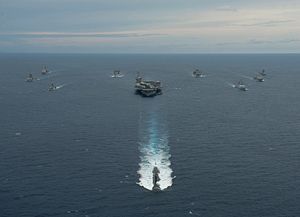On Tuesday, the U.S. navy confirmed that a U.S. fast-attack submarine arrived at a Philippine naval base.
According to the U.S. navy in a statement, the Los Angeles-class fast-attack submarine USS Topeka (SSN 754) arrived at Subic Bay on January 12 as part of what was termed “its routine Indo Asia-Pacific deployment.”
Topeka, which is around 300 feet long and weighs more than 6,000 tons, is capable of operating at depths greater than 800 feet at speeds up to 25 nautical miles per hour. Considered one of the world’s stealthiest submarines, it is capable of supporting various missions including anti-submarine warfare, anti-surface ship warfare, strike, surveillance and reconnaissance.
The U.S. navy statement classified the USS Topeka’s trip as a port visit that offered an opportunity for both sides to foster valuable cultural exchange and enhance their bilateral relationship. The statement did not clarify what Topeka activities would exactly entail except that it would conduct “a multitude of missions.”
“With a crew of 160 Sailors, Topeka will conduct a multitude of missions and maintain proficiency of the latest capabilities of the submarine fleet,” the statement said.
Despite the alleged “routine” nature of the deployment, the submarine’s presence attracted media attention because of its timing. As I reported earlier this week, its arrival coincided with news that the Philippine Supreme Court had finally upheld the constitutionality of the Enhanced Defense Cooperation Agreement (EDCA), a pact that the Philippines had inked with the United States back in April 2014 (See: “Philippine Court Upholds New US Defense Pact”). Among other things, EDCA would give U.S. troops and equipment wide access to Philippine military bases on a rotational basis.
It also coincided with bilateral discussions between the United States and the Philippines in Washington, D.C. On Tuesday, Philippine Foreign Secretary Albert del Rosario and Defense Secretary Voltaire Gazmin met with their U.S. counterparts U.S. Secretary of State John Kerry and U.S. Defense Secretary Ashton Carter for the so-called 2+2 ministerial meeting. Both sides were expected to discuss a range of issues, including U.S. assistance with Philippine military modernization plans and ongoing disputes in the South China Sea, in which Manila is a claimant. As I reported last year, Subic Bay, where Topeka arrived, was a former U.S. naval facility and the Philippines had decided to reopen it to serve as a military base for the first time in more than two decades (See: “Philippines to Open Former US Naval Base Near South China Sea in 2016”).

































